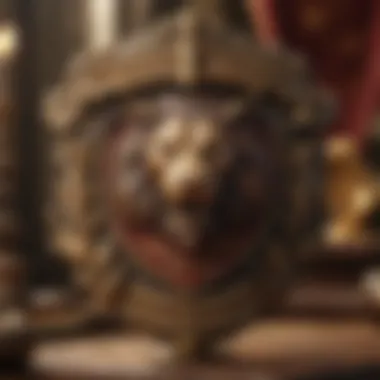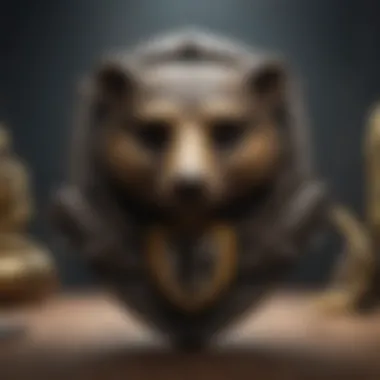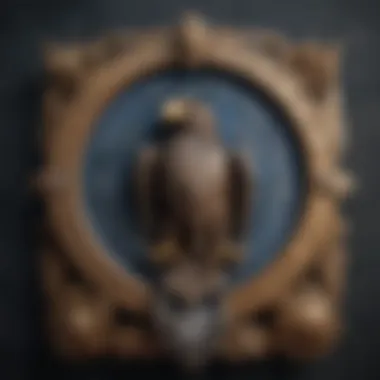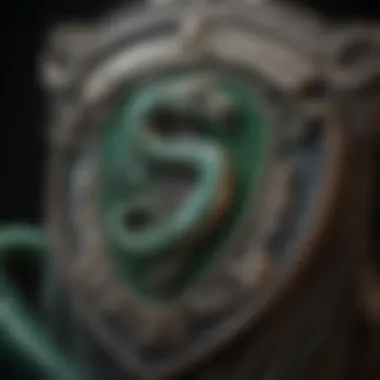Decoding the Hogwarts House Test: A Deep Dive


Intro
The Hogwarts House Test occupies a central place in the Harry Potter universe, serving as an essential tool for many fans. This assessment not only reveals intrinsic qualities but also suggests where individuals might find a sense of belonging. Each Hogwarts house—Gryffindor, Hufflepuff, Ravenclaw, and Slytherin—embodies values and traits that resonate with different personalities.
Exploring the significance of the Hogwarts House Test allows one to understand how these fictional houses reflect real-world dynamics in personality and identity. This article discusses various aspects that deepen understanding of this unique test, revealing its implications both within and beyond the pages of J.K. Rowling's work. By examining the underlying principles of each house, readers can connect with the narrative on a more personal level.
A comprehensive guide to the Hogwarts House Test is imperative for those looking to engage with the themes of bravery, loyalty, wisdom, or ambition that the houses represent. Understanding your placement in one of these houses can spark reflections on personal values, choices, and even life aspirations in the real world.
"The point of education is not to fill a bucket, but to light a fire." This thought resonates with how the Hogwarts framework aims to ignite self-discovery and belonging through its magical yet relatable narrative.
Prelude to the Hogwarts House System
The Hogwarts House System plays a crucial role in the Harry Potter universe, serving as a framework that categorizes students based on distinct characteristics and values. Each house, namely Gryffindor, Hufflepuff, Ravenclaw, and Slytherin, embodies unique traits that resonate deeply with fans and new learners alike. This classification not only influences personal identity within the fictional school but extends to real-world applications in social dynamics and community belonging.
Understanding the house system is essential because it allows individuals to reflect on their own qualities and preferences. For many, taking the Hogwarts House Test is more than just a fun quiz; it provides insights into self-knowledge and affiliation. The sorting process highlights key personality traits that may influence how individuals interact with others or approach challenges in their lives.
The benefits of engaging with the house system include fostering a sense of community and belonging. When individuals identify with a specific house, it forms a common ground for interaction and shared experiences. This can be especially impactful in modern contexts, where online platforms and fandoms create spaces for enthusiasts to connect over their house identities.
In considering the house system, it is worthwhile to reflect on how it serves as a metaphor for personal values and ambition. Each house's characteristics can spark meaningful conversations about one’s goals, ethics, and the ways individuals navigate friendships and rivalries. Overall, the Hogwarts House System is more than an element of a beloved series; it incites a deeper understanding of self and societal roles, making it relevant both in the magical and the mundane world.
Overview of the Hogwarts House Test
The Hogwarts House Test is more than a simple online quiz; it is a reflection of individual values and personal identity within the rich tapestry of the Harry Potter universe. Many fans engage with this test as a means of exploring their own characteristics and comparing them to the four iconic houses: Gryffindor, Hufflepuff, Ravenclaw, and Slytherin. Understanding this test can enhance one's appreciation for both the fictional world and the parallels in real-life social dynamics.
The importance of this section rests on elaborating key elements of the test. It serves to familiarize readers with its legitimacy and relevance. For enthusiasts, determining one's house can create a sense of belonging or community. Moreover, it often instigates deeper introspection about personal traits, aspirations, and even moral philosophies, making it a worthwhile psychological exercise.
History of the Test
Originating from J.K. Rowling's literary series, the Hogwarts House Test has transformed from a narrative device into an interactive experience favored among fans. While the idea of sorting students into houses comes from the story itself, various iterations of the test have emerged over the years, gaining popularity on websites, forums, and social media. Early online platforms attempted to emulate the Sorting Hat's magic as closely as possible, allowing fans to determine their alignment with a house based on their answers to a series of questions. As with any cultural phenomenon, the test has evolved, reflecting changes in community engagement and the growing desire for personalization and connection within the fan base.
Purpose and Functionality
The primary purpose of the Hogwarts House Test is to categorize individuals based on inherent traits that align with each house's philosophy and values. This functionality not only serves the user experience of fans but also taps into deeper sociological concepts. By comparing oneself with established archetypes, individuals can glean insights into their behavior and preferences.
- Self-Reflection: The test provides an opportunity for self-discovery. Many individuals find themselves pondering why they identify with a particular house, leading them to examine their principles and motivations.
- Community Building: Within fan culture, the results can facilitate conversations among individuals with similar values. Discussions often arise around house traits and how they contribute to relationships and social circles.
- Entertainment Value: Engaging with the test is also a source of enjoyment for fans. It invites participation in a shared cultural narrative, fostering connections between people who may otherwise be strangers.
"The Hogwarts House Test is not just a sorting mechanism; it's a catalyst for identity exploration, social interaction, and enjoyment within the fan community."
The Four Houses Explained
The Hogwarts House System is central to the identity of individuals within the Harry Potter universe. Understanding the four houses—Gryffindor, Hufflepuff, Ravenclaw, and Slytherin—provides valuable insights into not just the narrative but also self-perception and community dynamics. Each house represents distinct values, traits, and philosophies that shape the members’ identities. This section will explore these four houses in detail, illustrating their characteristics and how they influence both fictional narratives and real-world interactions.
Gryffindor: Characteristics and Values
Gryffindor is synonymous with bravery, courage, and a desire for justice. Founded by Godric Gryffindor, this house values bold actions and often prioritizes ethics over practicality. The symbol of Gryffindor is the lion, reflecting strength and valor both physically and morally.
Members of Gryffindor tend to exhibit occasional impulsiveness, a trait born from their deep-seated passion for what is right. Notable characters include Harry Potter and Hermione Granger, whose choices demonstrate a commitment to defending their beliefs.


Hufflepuff: Characteristics and Values
Hufflepuff, founded by Helga Hufflepuff, stands for loyalty, patience, and a strong work ethic. The badger emblem signifies a sense of community and tenacity in overcoming challenges. Hufflepuffs are known for their inclusivity, creating a warm and welcoming environment for all.
While they may not seek the spotlight, their contributions are immense. They value dedication over daring, emphasizing teamwork and support for one another, which is often overlooked in discussions about house ideals.
Ravenclaw: Characteristics and Values
Ravenclaw emphasizes intellect, wisdom, and a love for learning. Founded by Rowena Ravenclaw, the house values creativity and the pursuit of knowledge above all else. The eagle symbolizes the elevation of thought and the quest for understanding.
Ravenclaws are often seen as cerebral and thoughtful, approaching problems analytically and valuing critical thinking. Notable figures from this house, like Luna Lovegood, highlight that curiosity and individuality are celebrated traits within this community.
Slytherin: Characteristics and Values
Slytherin, founded by Salazar Slytherin, is often misinterpreted. Known for ambition and cunning, its members value resourcefulness and are willing to strategize to achieve their goals. The serpent symbolizes this shrewdness and capability.
Despite a tendency towards rivalry, especially with Gryffindor, Slytherins can exhibit loyalty and tenacity. Important characters include Severus Snape and Draco Malfoy, who show that ambition can coexist with complex moral dilemmas. It is essential to recognize that traits associated with Slytherin are valuable in contexts that require leadership and determination.
Each house contributes uniquely to the Hogwarts experience, shaping personalities and fostering community bonds.
Through these four houses, the Hogwarts House Test taps into innate qualities and preferences, allowing individuals to find a sense of belonging within the broader Harry Potter universe.
The Mechanics of Taking the House Test
The Hogwarts House Test is a pivotal element in understanding one’s identity within the magical world created by J.K. Rowling. Not only does it showcase the deep roots of each house, but it also resonates with individual experiences and preferences. The mechanics of this test are crucial as they determine the format and structure one engages with while seeking to uncover their inner qualities.
Test Formats: Online vs. Interactive
In today’s digital age, the House Test can be approached through various formats. The online test is often a quick questionnaire that offers a swift insight into which house aligns with one's traits. Generally, these are subjective questions, which require introspection. One benefit of the online format is convenience; it can be taken anytime, anywhere, often yielding immediate results. However, there can be limitations. Online tests may oversimplify complex qualities into shallow responses, possibly missing nuanced traits.
On the other hand, interactive tests tend to offer a more immersive experience. These can range from in-person sorting ceremonies to simulations where participants actively engage in scenarios that reflect house values. Two notable benefits of interactive formats are the depth of engagement and the ability to witness real-time personality manifestations. It allows individuals to reflect on their choices as they make them, which can lead to richer outcomes. Yet, these formats often require more commitment, and logistics can be a barrier.
Ultimately, the choice between online and interactive is personal and influenced by comfort level and desired depth of engagement. Both formats offer unique insights into the house system.
Common Questions and Themes
When preparing to take the House Test, certain questions often draw attention. Here are some common inquiries prevalent among participants:
- What qualities are most valued in each house?
- How should personal experiences influence my answers?
- Can I be sorted into more than one house?
These questions are part of a broader theme surrounding identity formation. The quest to understand how one's past, relationships, and aspirations intertwine with house characteristics fuels much of the test-taking experience. Many seek clarity, often wrestling with their ideals versus the traits associated with specific houses. Therefore, it’s not just a test; it's a journey into self-awareness.
The House Test's structure reflects traditional narratives while encouraging introspection. Ultimately, navigating these questions can lead to revelations about one's place in the world, both within the magical sphere and everyday life.
"The House Test provides not merely a categorization, but a doorway for individuals to explore the essence of who they are and how they relate to others in the vast tapestry of society."
Understanding the mechanics behind the Hogwarts House Test allows individuals to better appreciate their journey. Whether through swift online assessments or immersive experiences, each interaction reveals insights that carry relevance beyond the Harry Potter universe.


Psychological Aspects of the Hogwarts House Test
The Hogwarts House Test is not merely a whimsical activity for fans of the Harry Potter series; it functions on a deeper psychological level. Understanding these psychological aspects can reveal how the test aids individuals in self-discovery and identity exploration. It prompts individuals to reflect on their traits and values, which is crucial as they navigate both personal and social realms.
Identity Formation and Projected Traits
Identity formation plays a significant role in an individual's development. The Hogwarts House Test encourages participants to examine their attributes closely. When answering questions about preferences and decisions, individuals often project traits they aspire to embody. For instance, a person may view themselves as brave, aligning with Gryffindor, even if their actions contradict this ambition. This projection assists in exploring personal aspirations and can lead to growth.
Additionally, the values associated with each house—courage, loyalty, intelligence, and ambition—serve as benchmarks for self-evaluation. Individuals may discover traits they had previously overlooked or not recognized. This can initiate a journey of self-improvement by setting goals aligned with one's desired house identity. As a result, the test can cultivate a strong sense of belonging and purpose among participants.
The Influence of External Factors
External factors significantly shape how individuals perceive themselves and their assigned Hogwarts house. Family, peers, and broader cultural narratives contribute to this perception. Often, individuals are influenced by societal expectations or familial backgrounds while taking the test. If one's family highly values intelligence, a participant may unconsciously lean towards Ravenclaw, even if they resonate more personally with different traits.
Social dynamics thrive on shared experiences, especially within the fandom community. Those who engage with similar interests may find solace in discussing their house affiliation. This can reinforce bonds and establish an identity connected to a broader group, which is particularly vital in a digital age where online communities play a central role in identity construction.
"The house test is a mirror reflecting how we see ourselves in relation to the values represented by each house."
By understanding these elements, participants can harness the test not only to define who they are but also to grow into who they aspire to be.
Implications of House Identification
The Hogwarts House Test not only proposes a fundamental framework for self-discovery within the Harry Potter narrative but also deeply influences social structures and personal interactions in both fictional and real-world settings. Understanding one's Hogwarts house can carry significant implications in terms of identity consolidation, social dynamics, and interpersonal relationships. It extends beyond mere categorization; rather, it forms a lens through which individuals interpret their behaviors, values, and decisions.
Social Dynamics within the Community
Identification with a specific Hogwarts house can significantly impact social dynamics. Each house embodies distinct traits and values, catalyzing connections between those with similar characteristics. For instance, Gryffindor members may bond over shared values of bravery and daring, while Hufflepuff individuals often find common ground in their dedication and work ethic. This alignment creates cohesive networks where members support one another fostering camaraderie.
Moreover, house identity can promote a sense of belonging. When individuals embody the characteristics of their assigned house, they may experience an enhanced connection not only with fellow house members but also with the broader community that shares an interest in the Harry Potter universe. Such community ties can foster discussion and collaboration, both online and in everyday interactions.
"Belonging to a Hogwarts house goes beyond fantasy—it's a way to navigate social landscapes."
Applications in Real Life: Social Groups and Matching
The principles behind the Hogwarts House Test can also be seen in real-life social structures, influencing how individuals navigate their social groups. Many people instinctively gravitate towards communities that reflect their inherent traits and values. Whether in educational institutions, workplace environments, or broader social circles, the allegiances formed due to house identification often lead to friendships and collaborations based on similar interests.
When people identify with specific houses, they not only establish connections but also create opportunities for strategic social matching. For example, individualists may find themselves among other Ravenclaws, who share the pursuit of knowledge and intellectual challenge. Conversely, those aligned with Slytherin may form alliances in competitive environments or business contexts, utilizing their ambition and resourcefulness.
In summary, understanding the implications of house identification reveals the diverse layers through which the Hogwarts House Test influences social dynamics and relationships. By examining how house traits can shape interactions, one can gain greater insight into both personal identity and its reflection within the community.
Critical Perspectives on the House System
The Hogwarts House System has gained significant traction not only as a means of categorizing individuals within the wizarding world, but also as a tool for exploring broader societal perspectives. The concept of categorizing individuals into distinct groups resonates with many on various levels, whether in academic discussions or personal reflections. This section aims to illuminate the aspects of stereotyping and bias associated with the House System, while also probing into the ideological debates surrounding meritocracy and inheritance.
Debates on Stereotyping and Bias
The House System often facilitates an environment where preconceived notions and stereotypes take root. Each house embodies specific traits and characteristics that can lead to biases about individuals affiliated with them. For instance, Gryffindor members might be stereotyped as reckless or overly brave, while Slytherins may be seen as cunning or untrustworthy. Such categorizations can be limiting, oversimplifying the complex personalities that individuals possess.


Critics argue that this oversimplification fosters an atmosphere of exclusion, where certain behavioral traits are presumed based solely on house affiliation. This can affect personal interactions, leading to unjust prejudices between individuals from different houses. The potential for bias extends beyond just social interactions; it can seep into fandom discussions, affecting how fans communicate and engage with one another.
Ultimately, understanding these biases is crucial for fostering a more inclusive and respectful environment within the broader Harry Potter community. Addressing these stereotypes allows for a richer exploration of character depth and personal identity that transcends the limitations imposed by the House System.
Meritocracy vs. Inheritance in House Ideals
The ideals propagated by the House System also prompt discussions about meritocracy and inheritance. Each house claims to represent certain virtues—courage in Gryffindor, hard work in Hufflepuff, intelligence in Ravenclaw, and ambition in Slytherin. However, these ideals often come into question when one considers the backgrounds of the individuals sorted into these houses.
For example, the idea of being sorted based on merit rather than family reputation raises important questions. Are individuals truly embraced for their qualities, or are they often pre-judged based on their family lineage? The prevalence of legacy sorting within houses can reinforce ideas of privilege in a way that undermines the meritocratic ideals they aspire to uphold.
As fans engage with these themes, it becomes evident that the House System represents a complex interplay of identity and societal structures. A critical perspective allows for deeper discussions about how these factors shape the experiences of individuals within the Hogwarts framework.
By examining these issues, the community can encourage a dialogue that challenges existing norms and embraces a broader understanding of belonging and identity. This critical examination is pivotal not only for fans but also for those who seek to understand the implications of such systems in real-world contexts.
The Cultural Impact of the House Test
The Hogwarts House Test has ingrained itself in the cultural fabric of the Harry Potter universe. Its significance extends far beyond simple fan engagement; it shapes how individuals perceive themselves and connect with others. Understanding this cultural impact involves assessing how the test has influenced social interactions, community dynamics, and creative expressions across various platforms.
The House Test encourages personal reflection and community engagement. Fans identify with particular houses based on intrinsic qualities, which creates a shared language among them. This fosters a sense of belonging and identity, not just within the realm of Harry Potter fandom but also in broader social contexts. The process of sorting into a house can influence friendships and group affiliations, often guiding how individuals interact in both online and real-world settings.
Influence on Fan Culture and Fandom
The influence of the Hogwarts House Test on fan culture is profound. Online platforms like Reddit and Facebook are filled with discussions about house traits and preferences. Fans often engage in debates about which house embodies certain ideals or which qualities are most desirable. This invariably solidifies their connection to the series.
Moreover, fan communities often organize themselves around house identities. In forums and social media groups, members passionately defend their house's values. Event gatherings, such as themed parties or Harry Potter trivia nights, often align with house themes, providing a space for fans to bond over shared qualities. This sense of community reflects the unity fostered by the House Test while generating a unique culture that thrives on collective identity.
Creative Expressions: Cosplay and Interpretations
Cosplay within the Harry Potter fandom highlights the artistic expressions motivated by the House Test. Many fans adopt their favorite house's colors, symbols, and attire in cosplays, showing their house allegiance.
Here are some common ways fans express their house identities through creativity:
- Costuming: Creating accurate costumes that represent their chosen house.
- Fan Art: Illustrating representations of characters with specific house traits or themes.
- Writing: Crafting fan fiction centered around house dynamics, exploring the relationships within the Hogwarts framework.
These expressions not only display personal identities but also provide avenues for fan interaction and creativity. By engaging in these activities, fans deepen their connection to both the characters and each other, making their experiences more meaningful.
In a world where everyone seeks connection, the Hogwarts House Test acts as a bridge, uniting diverse individuals through shared values and creative expression.
Ultimately, the cultural impact of the House Test resonates through various platforms and forms. Whether through lively discussions, community events, or artistic forms of expression, it underscores how a fictional construct can genuinely influence real-world interactions and identities.
Finale: The Relevance of the House Test Today
The Hogwarts House Test continues to resonate significantly in both fictional and actual settings. As we navigate through a world increasingly influenced by digital and social media, understanding one's house emerges as more than just an entertaining pursuit. The test serves to build a sense of identity and community, particularly among fans of the Harry Potter series.
First, the house test cultivates a strong connection among enthusiasts. Many engage with this aspect of the Harry Potter universe by participating in discussions on platforms like Reddit and Facebook. Fans often share their personal reflections based on their house traits. This interaction fosters a sense of belonging in a global community united by shared interests. Moreover, it encourages deeper conversations about values such as bravery, loyalty, intelligence, and ambition.
It's also crucial to recognize the implications of house identification in modern society. Just as children in the series are grouped based on their qualities, individuals today often find themselves aligning with social groups that reflect similar interests or characteristics. This phenomenon can be observed in various contexts, from educational environments to workplaces. Choosing a house can mirror one's values and motivations in life.
Additionally, the psychological aspect of the house test cannot be overlooked. It sets a foundation for exploring personal identity and understanding why individuals resonate with particular traits. The alignment with a house serves as a lens through which personal qualities can be examined. Individuals may feel more empowered to embrace their strengths, even as they confront external challenges.
"Understanding one's Hogwarts house is akin to revealing layers of personality and potential. It drives a deeper comprehension of oneself and others."
In summary, the Hogwarts House Test remains relevant as it bridges fictional concepts with real-world applications. It transcends the pages of a book or the scenes of a film, finding roots in human behavior and social connections. Ultimately, recognizing one's house and what it represents encourages a broader exploration of identity, belonging, and community. The test may have originated in a fantastical realm, but its impact is tangible and significant in today's diverse societal landscape.







